September 14, 2018
Air Date: September 14, 2018
FULL SHOW
SEGMENTS
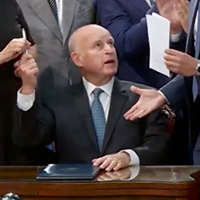
California Moves Toward Carbon-Free Economy
View the page for this story
A new law puts California on a path to carbon-free electricity generation by 2045. And leaders from around the world recently convened in San Francisco at the Global Climate Action Summit organized by the state’s Governor, Jerry Brown. Host Steve Curwood and Jared Blumenfeld, former EPA Regional Chief, discuss the state’s swift progress towards decarbonizing its growing economy and why some citizen activists say even stronger action is needed. (12:02)
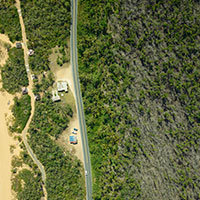
Resilience In Puerto Rico’s Tropical Forests After Hurricane Maria
/ Bobby BascombView the page for this story
When Hurricane Maria struck Puerto Rico in 2017, the direct hit turned a green island brown. Vast areas of forest were defoliated, or stripped of their leaves and branches. From mangroves to cloud forests, every ecosystem on the island was devastated by the massive storm, but as Living on Earth’s Bobby Bascomb reports, forests that evolved in the hurricane belt have ways to cope and are coming back. (14:04)
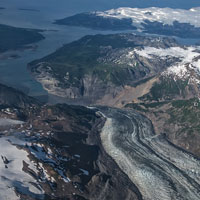
Beyond The Headlines
/ Peter DykstraView the page for this story
Peter Dykstra and Host Steve Curwood discuss why climate change may be linked to tsunamis, and they also look at the “research whaling” claims that allow the commercial killing of whales in Japan. The two then recount some of the deadliest hurricanes in modern US history. (03:43)
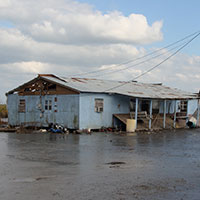
Rising: Dispatches From The New American Shore
View the page for this story
As ocean levels rise, coastal communities contend with higher floods, stronger hurricanes, and saltwater intrusion. Some are even being forced to retreat to higher ground. From Louisiana to Staten Island to Pensacola, writer Elizabeth Rush set out to document the stories of people caught in these rising tides. Rush speaks with Host Steve Curwood about her new book, Rising: Dispatches from the New American Shore. (14:16)
Show Credits and Funders
Show Transcript
HOST: Steve Curwood, Bobby Bascomb
GUESTS: Jared Blumenfeld, Elizabeth Rush
REPORTERS: Bobby Bascomb, Peter Dykstra
[THEME]
CURWOOD: From Public Radio International – this is Living on Earth.
[THEME]
CURWOOD: I'm Steve Curwood.
BASCOMB: And I’m Bobby Bascomb.
As hurricane Florence smashes and soaks the East Coast, we look back at the beating that Hurricane Maria delivered to Puerto Rico’s forests.
MORTON: So, some of the most striking images following Hurricane Maria were looking up at El Yunque National Forest and seeing nothing but brown on what had been this brilliant green hillside. It’s almost like you took a tropical rainforest and you turned it into a New England woodland in December.
CURWOOD: Also, California hosts a global call for action on climate.
BLUMENFELD: I've talked to people whose houses were burnt down, Republicans in the state, and they're like, this is not a political issue anymore. When your house is burnt down, when you're covered by a mudslide, when your house gets knocked over by a hurricane -- it really ceases to be a political issue pretty quickly.
BASCOMB: That and more this week on Living on Earth – Stick Around!
[NEWSBREAK MUSIC: Boards Of Canada “Zoetrope” from “In A Beautiful Place Out In The Country” (Warp Records 2000)]
[THEME]
California Moves Toward Carbon-Free Economy
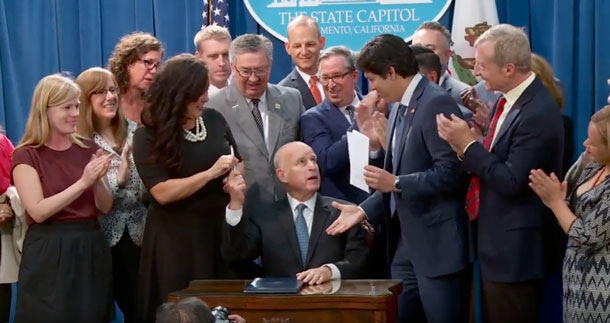
On September 10th, California Gov. Jerry Brown signed SB100, a law that puts the state on a path towards carbon-free electricity generation by 2045. (Photo: California Senate Democrats, Youtube)
CURWOOD: From PRI and the Jennifer and Ted Stanley Studios at the University of Massachusetts Boston, this is Living on Earth. I’m Steve Curwood.
BASCOMB: And I’m Bobby Bascomb.
It has been a big week for weather and the climate. This is the second year in a row for monster hurricanes. A killer storm named Florence is laying waste to the home ground of millions of Americans as we record this. And later in the broadcast we’ll continue our series looking back at the impact of hurricane Maria in Puerto Rico. The growing frequency of major hurricanes is linked to climate change, and recently the UN Secretary General, Antonio Guterres, warned the world is close to a tipping point of runaway climate disruption. He called on world leaders to act before 2020, declaring climate change is “the defining issue of our time and we are at a defining moment.”
The UN chief’s call for action was echoed by the Global Climate action summit in San Francisco.
[SOUNDS OF MARCH]
MARCHERS CHANTING: Rise up, all the people of the world, all the people of the world, rise up!
CURWOOD: California’s robust bi-partisan approach resulted in meeting key goals to cut global warming gases four years earlier than state law required. And the Golden State recently enacted a law that calls for 100 percent carbon-free energy by 2045. Former EPA regional administrator and Podship Earth host Jared Blumenfeld joins us now. Welcome to Living on Earth!
BLUMENFELD: Thank you. It's great to be here. It's an honor.
CURWOOD: Why do you think California is the epicenter of climate action in the United States?
BLUMENFELD: So, California is kind of where the environmental movement started, Steve. In many ways we had the spill in 1969 off Santa Barbara. We have still the worst air quality in the United States in LA and in our Central Valley, and the other thing is that people move to California because they love the outdoors. So, when you combine all these things, you've got big environmental challenges and a lot of opportunity to spend time in nature, this is a big issue for people. People care about it viscerally. They really want to do things in their everyday life, and they want to make sure that politicians are doing things, to bring the reality of climate reduction and climate adaptation to the center of the political debate. And there's a lot of thought and attention that's been paid to, how do we transition to a clean economy, how do we transition to a carbon zero economy, and make our economy strong? So, California is now the fifth largest economy in the world, it overtook the United Kingdom where I grew up -- I think maybe because they passed Brexit -- and that gives us a pretty good bully pulpit. And Jerry Brown this week has taken advantage of that at the Global Climate Action Summit. Leaders came from around the world and they really committed to up their game, and I think they wouldn't have done that if California hadn't been in a position of leadership.
CURWOOD: So, now how significant is California's new legislation, that Governor Jerry Brown has now signed? It calls for the state to receive all of its electricity from carbon-free sources by 2045.
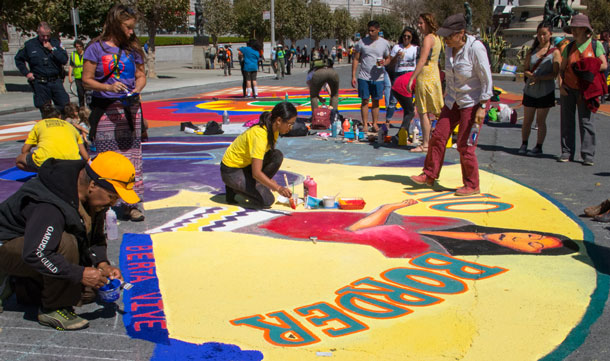
Activists covered San Francisco’s UN and Civic Center Plazas in nearly 50 murals on September 8, 2018, during the Rise for Climate, Jobs, and Justice March. (Photo: Peg Hunter, Flickr CC BY-NC 2.0)
BLUMENFELD: It's a huge deal. I mean, saying you're going to go 100 percent carbon free by 2045 is significant. And certainly because we're such a large state with 40 million plus inhabitants, and in terms of Silicon Valley and all the things that California does, I think it says to the world it can be done, this is about leadership right now. And it sends a strong message to the rest of the world who kind of see the United States as a monolith -- they just see it as Trump and a White House that is really anti-environmental -- and this is sending a very different message, which is states like California are taking leadership, they will make a difference and they'll help us achieve the goals of the Paris Agreement.
CURWOOD: So, talk to me about how California is going to meet this ambitious goal of being carbon-free when it comes to energy production?
BLUMENFELD: So, Steve, we're already on our way, so this isn't kind of out of the blue. California is not just suddenly saying, oh my God, we need to do something. California has been on a path to get to 50 percent renewable energy. At the moment if you include large-scale hydro power, we're at about 40 percent, so we're on the way. And part of this was saying the utilities are having actually a pretty easy job of getting us to 50 percent, we need to up our game. But it isn't going to be easy.
One of the reasons is that if you think about solar, in particular, the peak amount of solar energy comes at midday at about 1 pm. In California we use the most amount of energy in our day at about 7 pm. And lots of times now in our year we're pushing energy to Arizona and Nevada -- we're actually paying them to take it -- because our grid at that time can't handle all the energy. At the same time we need energy later in the day. So, energy storage is really going to have to become a reality for California even to get to 60 percent renewable energy. One form that could take, Steve, would be through splitting water molecules into hydrogen and then storing that hydrogen and then using it at a different time of the day. Batteries are also a different form of storage that people are looking at, but at the moment I think hydrogen the one that people are betting on in terms of storage.
CURWOOD: Now, of course, hydrogen, you have two choices. You could burn it in today's combustion engine or you could put it in a fuel cell, and you would...?
BLUMENFELD: ...put it in a fuel cell. Primarily because it's more efficient. And it basically, if you think about hydrogen cars that are now on the road, Steve -- and there's more and more of them in California -- they are an electric vehicle, but rather than having a battery they have a fuel cell, and that fuel cell is powered by hydrogen.
CURWOOD: OK. So, the goal for electricity production is to be carbon free by 2045. What about the rest of the energy that California uses?
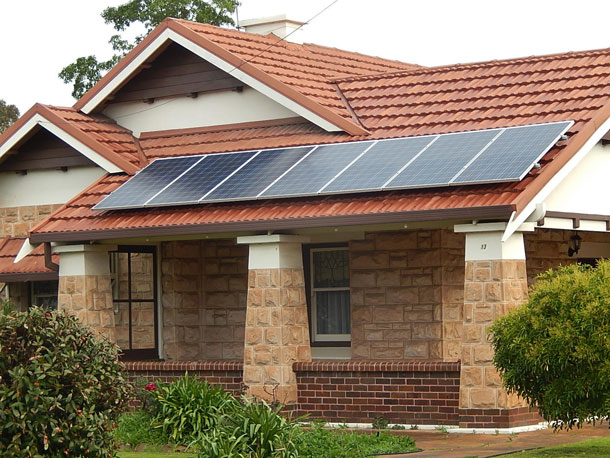
In May, 2018, California became the first state to require all new homes to have solar power. The requirement goes into effect in 2020. (Photo: Michael Coghlan, Flickr CC BY-SA 2.0)
BLUMENFELD: So, when you look at our greenhouse gas emissions, the majority of what we still have is produced by the transportation sector. With more than 40 million Californians, they have 29 million vehicles and a million of those are heavy duty trucks, so the governor has also come out with a pretty audacious goal in the transportation sector of $5 million zero emission vehicles by 2030. In some ways that's going to be much more difficult to meet than the renewable energy goals in that you really have to change hearts and minds of individual drivers, and what he said is we're going to have to build about $250,000 electric vehicle charging stations in the state. That's a massive infrastructure project and one of the benefits that California has, which kind of ties this all together, is that we have a cap and trade regime.
So companies, industries that want to pollute greenhouse gas emissions have to pay, and the total amount in the state keeps coming down and the permits get more and more expensive. So about $6 billion dollars, Steve, has already gone into this fund, the greenhouse gas reduction fund, and the revenue source is cap and trade. So, the governor has said we're going to put at least $1.5 billion dollars into this charging station network, we're going to really push the heavy duty vehicles to switch to things like electric vehicles like the Tesla long-haul vehicles that they're making, for instance. So, yeah, there's money behind these promises and I think they're going to get there. That being said, California still has the worst air quality of any state in the nation, and four out of five Californians live in a county that has air that does not meet federal standards. So, we've got this dichotomy between really forward-moving stuff and, at the same time, really stubborn challenges for our generally low income and minority communities in this state.
CURWOOD: So, let's just say that Governor Brown came to you tomorrow -- or maybe his successor, it could take a little while -- and said, "Jared Blumenfeld, you are now California's energy czar". What kind of policies would you put in place to keep California moving towards decarbonizing its economy?
BLUMENFELD: So, the first thing, Steve, really is implementing what we've already agreed to. So, this governor has done an amazing job of setting some big audacious goals around energy independence and moving us away from fossil fuels. And really a lot of that is now in the details of implementing it. So, for instance, the building codes -- things that aren't particularly sexy -- but there's 100,000 homes built every year in California, there was a law that was just passed to make sure that solar panels are on every single one of them. But the building interior needs to really get more even more efficient than it is right now. We have appliances in our homes like gas hot water heaters. Gas has kind of been in this transition from coal to renewables, and natural gas in California has really played an important role.
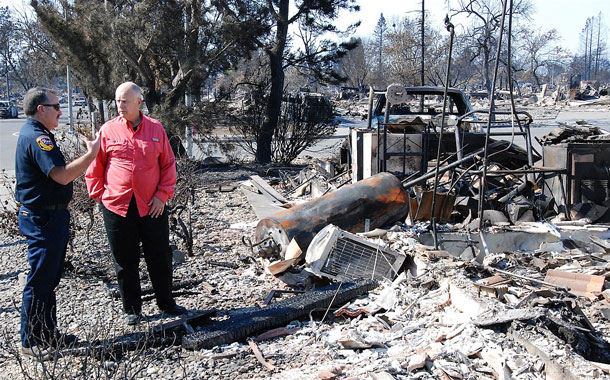
CAL FIRE Chief Scott Brown briefs California Governor Jerry Brown as they survey the damage caused by the wildfires in Santa Rosa, California, on October 14, 2017. Climate change is linked to an uptick in wildfires in the state. (Photo: Capt. Will Martin, Army National Guard)
But if we're going to reach these goals of getting rid of carbon in our environment, we really need to tackle things like hot water heaters in our homes. They're ubiquitous, there are lots of solutions that would be better for those. Other kind of really cool things that don't naturally sound like energy, but do have to do with carbon, are agricultural policy. So, California grows 25 percent of the fruits and vegetables for the entire nation, have a lot of farmland. That farmland could actually be used to absorb carbon from the atmosphere and improve the crops for farmers. So there's a lot of energy right now around these things, but unfortunately, Steve, things like wildfires -- forests in California used to be a place that absorbed carbon from the atmosphere and now they're a net emitter of carbon because they're burning. So, we're in a really difficult time when it comes to the state's ability even to meet its greenhouse gas reduction target.
CURWOOD: So, as the Global Climate Action Summit was revving up, I understand you went to the Rise for Climate March in San Francisco. What was the mood there?
BLUMENFELD: Steve, I’m not really a march-goer! It took kind of a big push to get me out the door to go to the march, but once I was there, I mean there was amazing energy. People were just super motivated to do something around climate change and minds have changed, but really more importantly hearts have changed, all across the political spectrum. Because this doesn't really, I've talked to people whose houses were burned down, Republicans in the state, and they're like this is not a political issue anymore. When your house is burnt down, when you're covered by a mudslide, when your house gets knocked over by a hurricane, it really ceases to be a political issue pretty quickly, so I think there is a coming together. One of the cool parts of the march was that there weren't any speakers. So, normally you’ve got these talking heads and kind of people with all these egos telling you what you should and shouldn't do.
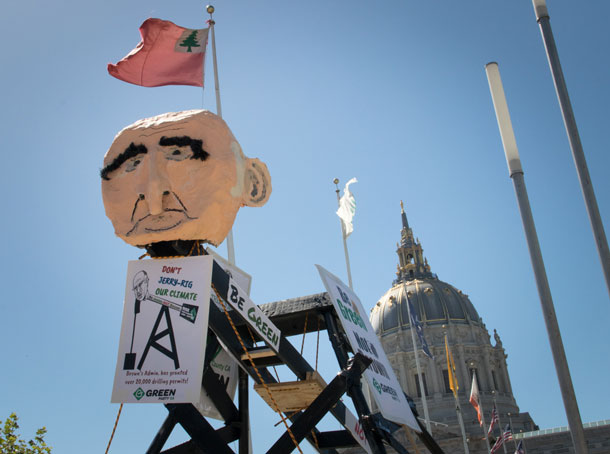
“Don't ‘Jerry-Rig’ our climate,” reads an effigy of California Governor Jerry Brown. Some activists who participated in the Rise for Climate March called out the Governor for granting more than 20,000 drilling permits. (Photo: Peg Hunter, Flickr CC BY-NC 2.0)
This was just people out on the street. There was marching bands. One of the interesting things was that people were saying, Jerry Brown's not doing enough, he really needs to keep the oil in the ground and they were saying that there's been a large increase on his watch of oil permits, and we need to make sure that the transition to a carbon free economy is just and equitable. Yeah, it's great to have cap and trade, but, you know what, they're buying permits to pollute in low-income minority communities and that's not OK. So, making this whole thing work for everyone in California I think is really important.
CURWOOD: Jared Blumenfeld is a former regional administrator of the EPA, and host of the new podcast, Podship Earth.
BLUMENFELD: I wanted to have conversations with people that it wasn’t about Trump, it wasn’t about politics. It’s really about why this fly fisherman on the McCloud River loves fishing. And, is he an environmentalist? Absolutely. Does he see himself as an environmentalist? Absolutely not. So we’ve kind of narrowed the tent of what it means to be an environmentalist. The goal of Podship Earth is to open it back up and say – we’re all part of nature, nature is part of us, and if we love it, we will protect it.
Related links:
- The text of SB-100, the new California law that requires 100% carbon-free electricity by 2045
- Vox | “California Gov. Jerry Brown casually unveils history’s most ambitious climate target”
- About the Global Climate Action Summit
- Rise for Climate, Jobs & Justice
- Digital Trends | “Hydrogen fuel cell vehicles are thriving in California”
- Podship Earth, Jared Blumenfeld’s environmental podcast
[MUSIC: Al Jolson, “California, Here I Come” on Best of Al Jolson, 20th Century Masters The Millennium Collection, by Buddy DeSylva and Joseph Meyer, MCA Records https://www.youtube.com/watch?v=7IjpAGf0oks ]
BASCOMB: Just ahead – built for hurricanes—the resiliency of a Puerto Rican tropical rainforest. Stay tuned to Living on Earth.
ANNOUNCER: Support for Living on Earth comes from the Gordon and Betty Moore Foundation and from a friend of Sailors for the Sea, working with boaters to restore ocean health.
[CUTAWAY MUSIC: David Grisman Quintet, “Argentine Trio” on Dawgnation, by David Grisman, Acoustic Disc]
Resilience In Puerto Rico’s Tropical Forests After Hurricane Maria
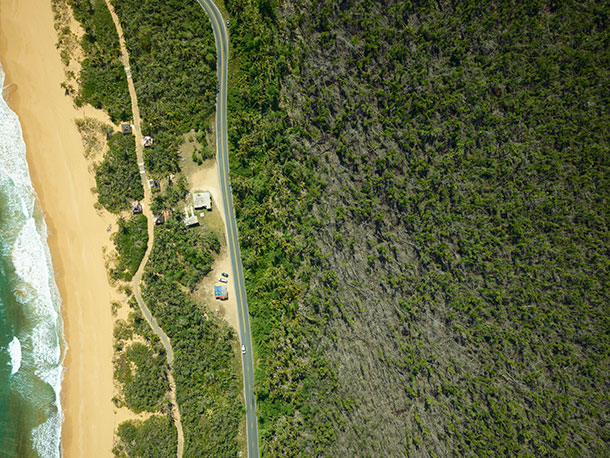
The decimation of mangroves along the Puerto Rican coastline after the hurricane in 2017. (Photo: Courtesy of NASA Goddard Space Flight Center)
CURWOOD: It’s Living on Earth. I’m Steve Curwood.
BASCOMB: And I’m Bobby Bascomb.
As the US struggles with the second catastrophic hurricane season in a row, through this month we are looking at the aftermath of 2017’s deadly Hurricane Maria in Puerto Rico. Along with the thousands of lives lost and countless homes and businesses destroyed, the intense winds and rains wreaked havoc on the natural environment.
NASA scientist Doug Morton had a bird’s-eye view of the effects of the storm on the island’s forests with the cameras from the Goddard Space Flight Center.
MORTON: Some of the most striking images following hurricane Maria were looking up at El Yunque National Forest from the ground below and seeing nothing but brown on what had been this brilliant green hillside. It’s almost like you took a tropical rainforest and you turned it into a New England woodland in December because you stripped off all of the leaves off almost all of the trees. The canopy literally went from green to brown.
BASCOMB: But of course, the plants and animals native to Puerto Rico evolved with hurricanes, so they have built-in ways to recover. As part of a trip I took to Puerto Rico 9 months after the hurricane I caught up with scientists who are documenting the destruction and resilience of nature.
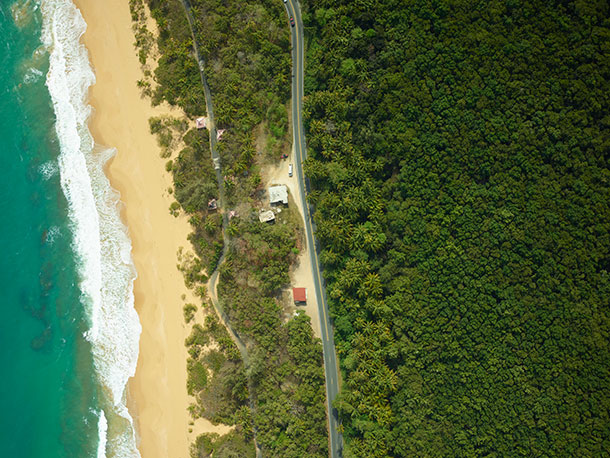
An aerial shot from before Hurricane Maria tore through this forest. (Photo: Courtesy of the NASA Goddard Space Flight Center)
[BIRDSONG]
BASCOMB: Are you Maria?
RIVERA: Yes. Nice to meet you.
BASCOMB: Nice to meet you, I’m Bobby.
BASCOMB: Here in El Yunque, this tropical rainforest is a gold mine of scientific research. Government scientists, like biologist Maria Rivera, have been maintaining research plots here for decades.
I met Maria at the Forest Service office building just past the entrance to El Yunque.
Dressed in the khaki and green uniform of the US Forest Service, she has been coming here once a week to collect data for the last 18 years. But she says she was shocked when she first saw the forest after the hurricane went through.
RIVERA: My first reaction was a bomb inside the forest.
BASCOMB: A bomb.
RIVERA: Yeah.
[SFX DRIVING SOUND]
BASCOMB: I tag along with Maria as she heads out in a Forest Service jeep to collect temperature, rainfall, and biomass data from her 24 experimental plots in the forest.
But first we must stop to check in with a Forest Service colleague with a clipboard. Maria rolls down the window to give her name and the time.
[DRIVING SOUND]
RIVERA: Buen Dias, Maria Rivera. Si. Nueve Catorce [9:15]. They take the time when you pass for safety.
BASCOMB: If we don’t return here by the end of the day Forest Service employees will come to look for us.
When I visit the park most of it is still closed to visitors.
Many roads are impassable with branches and tree limbs scattered about and some deforested hillsides are still unstable.
[SOUND OF CAR STOPPING]
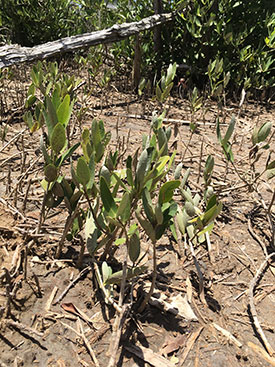
It’s a good time to be a mangrove sapling on the coast of Puerto Rico. The hurricane heavily damaged or killed nearly all the mangrove trees in some areas of the island, but tiny saplings take advantage of the new sunlight and space to grow. (Photo: Bobby Bascomb)
BASCOMB: We stop next to a huge landslide on the side of the road.
The ground is bare but for rocks and dead trees.
RIVERA: Look to the left. A lot of branches and the tree are dead.
BASCOMB: So, everything here is dead. It’s all brown and twisted and gnarled and pulled out from the ground even. It almost looks like a forest fire went through here.
RIVERA: Uh huh…
BASCOMB: She says the entire forest looked like this right after the hurricane struck.
[WALKING SOUNDS]
BASCOMB: We start the day at the very top of Luquillo mountain, some 3500 feet high, in a cloud forest.
RIVERA: This is my favorite area.
BASCOMB: It’s chilly, at least 20 degrees cooler than just a mile or so down the mountain.
The forest here has an ethereal quality. Wispy clouds settle around the trees like a damp blanket.
This area gets upwards of 200 inches of rain a year and is typically dripping with life.
Maria says before the hurricane struck nearly every surface in this forest was covered with moss and epiphytes growing in the crook of trees, but today it is nearly bare.
RIVERA: Very different, very different with the path for the hurricane. But recover, this is the nature! [LAUGHS]
BASCOMB: She says these short, stout, trees evolved to cope with high winds at the top of the mountain.
They were a small target to begin with, and when the hurricane blew through they simply dropped their leaves and weathered through the storm.
Very few trees here were actually uprooted and killed.
Still, when she came here about 6 months after the hurricane, Maria says she was stunned to see how the trees responded.
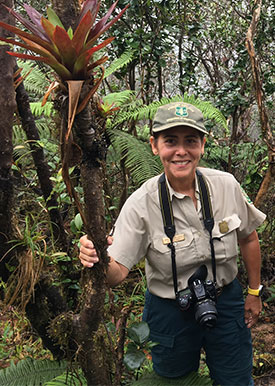
Biologist Maria Rivera in the cloud forest at El Yunque National Forest (Photo: Bobby Bascomb)
RIVERA: When I make a measure for [after] the hurricane, all trees they have flowers. It was very pretty. Not much leaves but when I see the flower I say, wow this is great.
BASCOMB: Across the entire island, trees set flowers and fruit outside their usual season.
It’s a stress response and survival mechanism to pass on their genes.
In a closed canopy forest the competition for sunlight can be fierce, but after a hurricane opens new space trees are in a race to drop seeds and fill that vacated spot.
[CAR DOOR SLAMS]
BASCOMB: We pile back into the Forest Service jeep and head just a few minutes down the mountain to a completely different ecosystem.
RIVERA: I’m going now to the palm area. It’s a different ecosystem, it’s palm.
BASCOMB: From the road near the top of the mountain we get an expansive view of the valley just below us.
From above the closed canopy of a tropical forest typically look a bit like broccoli.
But this forest looks more like spears of asparagus.
The trees have mostly grown their leaves back, but they are skinny with very few branches.
Maria says that’s how the palm trees were able to survive the hurricane.
RIVERA: The palm here, they don’t have branches.
BASCOMB: So, clinging to the side of the mountain, the wind just passed through the skinny palm trees.
But if a palm loses the branches it does have at the very top of the tree it will die, which is what happened to about 50 percent of the trees here.
They were decapitated.
The dead trees still standing look like matchsticks.
[DRIVING SOUNDS]
BASCOMB: We drive another 5 minutes down the mountain and come to yet another ecosystem.
RIVERA: This is the area of dry forest. Do you see to the left, do you see the trees?
BASCOMB: They’re all twisted.
RIVERA: Uh huh!
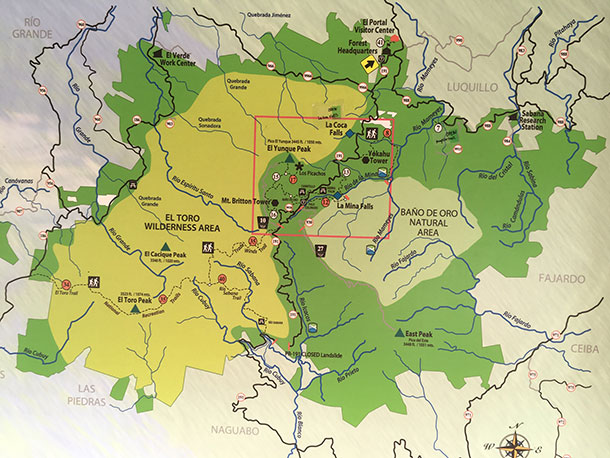
A map of El Yunque National Forest. Most of the park was closed to visitors after the hurricane. (Photo: Bobby Bascomb)
BASCOMB: So, the hurricane literally twisted the trunk of the tree itself.
RIVERA: Yes, yes, yes, yes.
BASCOMB: Wow.
[CAR DOOR CLOSES, WALKING SOUNDS]
RIVERA: So, this is the plot, the dry forest.
BASCOMB: Wow, it’s much hotter here.
RIVERA: I think 20 or more.
[BIRD CALL]
BASCOMB: Easily.
RIVERA: Yeah, yeah.
BASCOMB: The palm forest still looks quite devastated there. You don’t see the epiphytes growing on the tree trunks. It still looks like match sticks with just a little bit of growth growing out of the top of the palms. But this forest, it looks pretty green here. There are a lot of leaves, a lot of branches.
RIVERA: Yeah, yes. That point is ok. The recovery was very fast here.
BASCOMB: Maria says the old, weak, branches broke off, but healthier parts of the trees stayed intact and their leaves grew back quickly.
[DRIVING SOUNDS]
BASCOMB: To see the most heavily damaged ecosystem we head down the mountain again to the coast, where the hurricane first made landfall.
RIVERA: This is mangrove.
[WALKING SOUNDS]
BASCOMB: The mangrove forest is hot and sunny.
Maria says the ground was still covered in 10 inches of water the first time she came here after the hurricane.
Nearly all of the 50-foot-tall trees around us appear to be dead.
RIVERA: When I come here the first time I think all are dead. They don’t have leaves. They don’t have new growth.
BASCOMB: Mangroves make their living at the salty edge of the sea.
They thrive in salt water and are designed to withstand strong winds, so researchers were surprised to see that nearly all of the mangroves looked dead after Hurricane Maria came through.
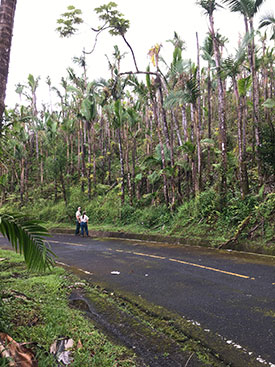
After Hurricane Maria many palm trees were left looking like matchsticks. (Photo: Bobby Bascomb)
Those biologists surmise that the salt water and sand blown against the mangroves essentially burned all the leaves and branches.
RIVERA: And do you see the sand here?
BASCOMB: Oh, on the side of the tree.
RIVERA: Yes, yes.
BASCOMB: But mangroves evolved to live in this harsh coastal environment in a region prone to hurricanes.
Maria Rivera points to some green shoots poking out at the bottom of a tree next to us.
RIVERA: Do you see? Down, down.
BASCOMB: See, that’s the thing, the tree itself looks dead but it’s not because it has these new shoots coming out from around the base of it.
RIVERA: Correct, correct. This is, I mention to you when I come the first time, I say all are dead. No! Not all are dead, they continue.
BASCOMB: The mangrove forest was the most devastated ecosystem on Puerto Rico, but given enough time, they will recover.
And since no other plant can easily grow in this harsh ecosystem they have no competition. Indeed, adding to the shoots on existing trees, a carpet of foot tall mangrove saplings covers the sandy ground.
[CAR SOUNDS]
BASCOMB: The recovery of Puerto Rico’s forests shows the value of a long-term study.
Over at the University of Puerto Rico’s Botanical Garden I met up with Ariel Lugo, director of the International Institute for Tropical Forestry
He says forest regrowth is exceptionally high following a devastating hurricane.
LUGO: The productivity of the forest right now is higher than it was before the hurricane.
BASCOMB: He says hurricanes can have both positive and negative effects on an ecosystem.
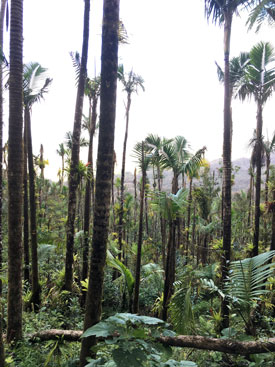
The palm forest in El Yunque National Forest. (Photo: Bobby Bascomb)
LUGO: In the first five years after the hurricane, what we found after Hugo was the fastest primary productivity that we've ever measured in the forest. When you destroy the canopy and you have to regrow that structure, the rate at which the forest regrows, which is a measure of its productivity, is the highest that we've ever measured before the hurricane, and it compares favorably with the rate of plantation forestry.
BASCOMB: He worries most about the slow pace of the mangrove recovery, specifically that they won’t likely be there when the next hurricane strikes.
LUGO: So, who is going to absorb the energy of the hurricane? Well, it’s going to be absorbed by structures, by human structures, and it’s going to be absorbed by other parts of the landscape, and so you are liable to see more landslides, and you're liable to see greater floods, etc.
BASCOMB: In the long term Lugo thinks the storm will be a recalibration.
Fit plants and animals will survive.
Older, weaker, less adapted and invasive species will not.
He estimates that the forests will need roughly 60 years to recover completely and the impacts of the hurricane raise enough questions to keep scientists like Maria Rivera busy for decades.
But for Maria, it’s more than just collecting data. She says seeing the devastation of the forest she knows so well was difficult at first.
RIVERA: The first impression was cry. I work here for 27 years. It was the first time when I see the devastation. But now is different now. For me now when I see the trees, when I see the green area, the feeling is different. I’m happy for that. I’m very happy.
CURWOOD: Thanks for that report, Bobby.
BASCOMB: Sure, Steve. You know, I actually came across another story in the course of my reporting from El Yunque. The timing didn’t work for me to check it out while I was there but I did speak with the researcher when I got back.
CURWOOD: Great, what’s the story?
BASCOMB: Well, Tana Wood is a lead scientist with a group called the Tropical Responses to Altered Climate Experiment, or TRACE, and she’s looking at how climate change might impact tropical forests.
CURWOOD: Cool, how are they doing that?
BASCOMB: They have 3 experimental plots in El Yunque National Forest. They set up infrared heaters there to actually raise the temperature of the forest 4 degrees Celsius, or about 7 degrees Fahrenheit, that’s the median temperature increase projected for the tropics by the end of the century. They want to see how tropical forests respond. Here’s Tana Wood.
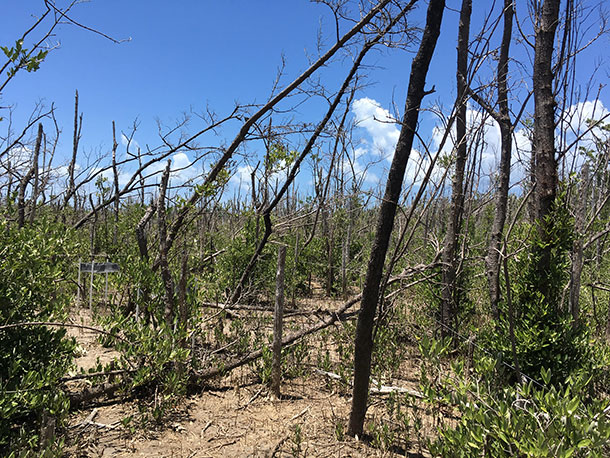
Mangrove forests were a first line of defense against the hurricane, and were the most heavily damaged type of forest. (Photo: Bobby Bascomb)
WOOD: We set up the experiment three years ago. We had one year of data collection that we did prior to starting the experiment, just to get what our baseline was. And then we started warming for a year and then the hurricane hit.
CURWOOD: Wow, so that must have thrown their experiment into chaos.
BASCOMB: It did for a while, but Tana says that now they actually have an even more interesting experiment. How do the tropical forests of a future, warmer planet, respond and recover after a hurricane?
CURWOOD: Ahh, right! What did they find?
BASCOMB: Basically, the warmer forest is slower to re-grow and sprout new saplings than their control plots. They also found that the warmer plots are sequestering less carbon dioxide.
WOOD: What we were starting to observe in our warmed plots, as part of the acclimation process, they were not photosynthesizing as much, which would mean less carbon coming into the plants and less carbon that could go into the roots.
BASCOMB: But, Steve, Tana Wood is quick to point out that even though the warmed forest isn’t doing quite as well as the control forest, this is still actually a positive news because the forest didn’t just die all together, it is able to recover.
WOOD: They’re coming back from the hurricane. The system seems able to respond. So the fact that they’re acclimating could mean, could be good news for the future of these forests.
CURWOOD: Well, thanks for that update, Bobby. And I’m looking forward to your next installment on the impacts of Hurricane Maria.
BASCOMB: Thanks Steve, you’re welcome.
Related links:
- International Institute of Tropical Forestry
- NASA’s Goddard Space Flight Center
- NASA’s G-LiHT Aerial Photography of Puerto Rico
[MUSIC: Gipsy Kings, “Obsesion De Amor” on Compas, by T. Baliardo, Nonesuch Records]
CURWOOD: You can hear our program anytime on our website, or get an audio download. The address is LOE dot org. That's LOE dot O-R-G. There you’ll also find pictures and more information about our stories. And we’d like to hear from you: You can reach us at comments @ l-o-e dot org. Once again, comments @ l-o-e dot O-R-G.
Our postal address is PO Box 990007, Boston, Massachusetts, 02199. And you can call our listener line anytime, at 617-287-4121. That's 617-287-41-21.
Coming up-- some things you might not expect from climate change. Keep listening to Living on Earth.
ANNOUNCER: Funding for Living on Earth comes from you our listeners and United Technologies, combining passion for science with engineering to create solutions designed for sustainability in aerospace, building industries, and food refrigeration. UTC companies such as Otis, Carrier, Pratt and Whitney, and UTC Aerospace systems are helping to move the world forward. You can learn more about United Technologies by tuning into the Race to Nine Billion podcast; listen at race to nine billion dot com. That’s race to nine billion dot com. This is PRI, Public Radio International.
[CUTAWAY MUSIC: David Grisman Quintet, “Slade” on Dawgnation, composed by David Grisman, Acoustic Disc]
Beyond The Headlines
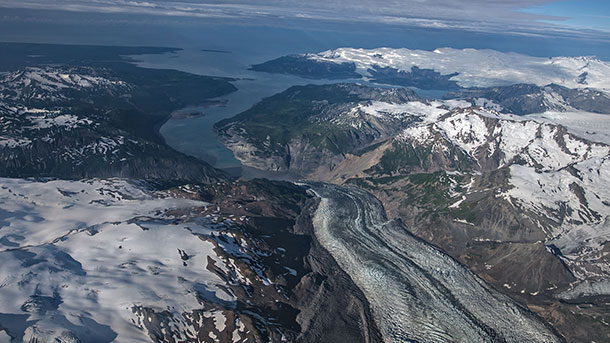
Tyndall Glacier to Taan Fjord in Southeastern, Alaska. (Photo: Richard Droker, Flickr CC BY-NC-ND 2.0)
BASCOMB: It’s Living on Earth, I’m Bobby Bascomb.
CURWOOD: And I’m Steve Curwood.
Well, let’s take a look beyond the headlines now with Peter Dykstra. He’s an editor with Environmental Health News that’s EHN dot org and Daily Climate dot org. Hi there, Peter!
DYKSTRA: Hi Steve.
CURWOOD: Hey, this year’s intense fire and hurricane season have a lot of people talking about climate change. What do you have for us today?
DYKSTRA: I’ve got a study that links something that you wouldn’t expect to be linked to climate change at all, to another natural disaster -- tsunamis. This is in the journal Scientific Reports. They looked at two tsunamis that were caused by rockslides when rocks were exposed from melting glaciers. One of them was in 2017 in Greenland. The tsunami killed four people in a town 20 miles away from the rockslide and in 2015, there was another slide and tsunami from the Tyndall glacier in Southeastern Alaska.
CURWOOD: Well you never know what disrupting the climate will do. What else do you have for us today?
DYKSTRA: Commercial whaling was outlawed in the year 1986.
CURWOOD: Okay, but what why are we taking about it still today?
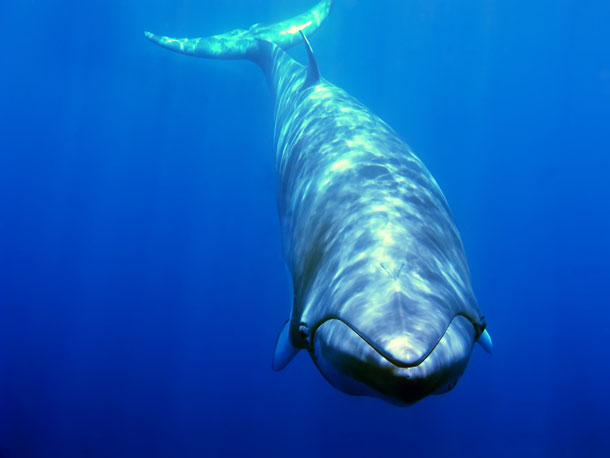
Minke whales, like the one pictured, have been hit particularly hard by whaling activity by Japan. (Photo: Wade Lehmann, Flickr CC BY-ND 2.0)
DYKSTRA: Because it never really ended. Japan has used a loophole in the commercial whaling ban, allowing for research whaling. Last year they killed 333 Minke whales in the Antarctic. It’s important to point out that Minke whales are not endangered, but there’s still an uproar about the reasons to kill whales at all in this day and age.
CURWOOD: So what’s the scientific research here?
DYKSTRA: Well after 32 years of research whaling, we’ve found out that these whales apparently died from large harpoon wounds, and when they’re taken back to Japan and prepared they are delicious.
CURWOOD: Hmm. So this is real science or junk science?
DYKSTRA: Well it’s clearly junk science, it’s been called a fraud, I would compare it to either clean coal or professional wrestling on the fraud scale.
CURWOOD: So what’s going on now about this?
DYKSTRA: The international whaling commission, the meeting in Brazil, and Japan is pushing the renewal of commercial whaling 32 years after we thought it was banned.
CURWOOD: Okay Peter, let’s take a look now into the history vault, what do you have for us this week?
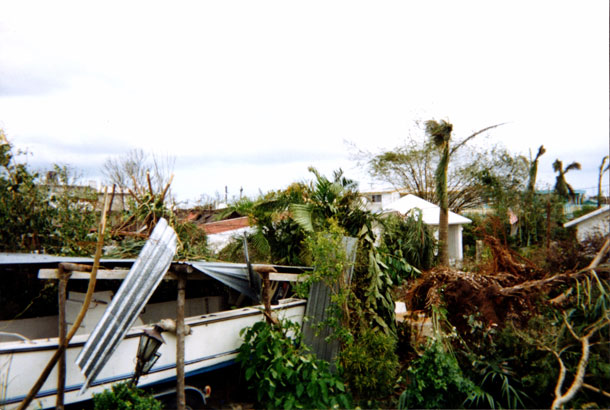
The wreckage after Hurricane Gilbert slammed the Mexican coastline in 1988. (Photo: Scott Baldwin, Flickr CC BY-NC-ND 2.0)
DYKSTRA: Well with hurricanes much on our mind, let’s take a look at a few anniversaries, this being, mid-September being the peak of hurricane season. On the 8th and 9th of September in the year 1900, the Galveston Hurricane. The low-end death toll 6,000, the high-end death toll 12,000. One of the worst hurricane disasters in history. On September 12th in 2005, Michael Brown resigned as the director of FEMA. He of course, was the guy that George W. Bush had said was doing a “heckuva job” before all of the details about the absolute fiasco of the response to Hurricane Katrina were discovered.
CURWOOD: And there’s some others I guess?
DYKSTRA: There are. On the 12th and 13th in the year 1928, a hurricane came up through the Caribbean, killed about 1,000 people in Puerto Rico, and killed another 2500 people in lake Okeechobee in Florida. And then, in 1988 also on the 12th and 13th, this is the 30th anniversary of Hurricane Gilbert. Hurricane Gilbert rampaged through the Caribbean then up to Texas, killing a total of 319 people.
CURWOOD: And science is telling us that has the Atlantic ocean warms due to climate disruption, the warming world will see more and more of these stronger storms. Oh boy.
DYKSTRA: Oh boy indeed.
CURWOOD: Thanks Peter. Peter’s an editor with Environmental Health News, that’s EHN.org, and DailyClimate.org. We’ll talk to you again real soon.
DYKSTRA: Alright Steve, thanks, talk to you soon.
CURWOOD: And there’s more on these stories at our website, LOE.org.
Related links:
- The Independent | "Melting glaciers increasing risk of landslide-triggered, tsunamis, study reveals"
- Agence France Presse | "Pro- and anti-whaling nations set for clash in Brazil"
- The Independent | "Japan slaughters 122 pregnant whales for 'scientific research'
- CNN | George W. Bush’s infamous "Brownie, you're doing a heckuva job" comment
- Okeechobee Hurricane History
[MUSIC: David Grisman Quintet, Why Did the Mouse Marry the Elephant?” on Dawgnation, by David Grisman, Acoustic Disc]
Rising: Dispatches From The New American Shore
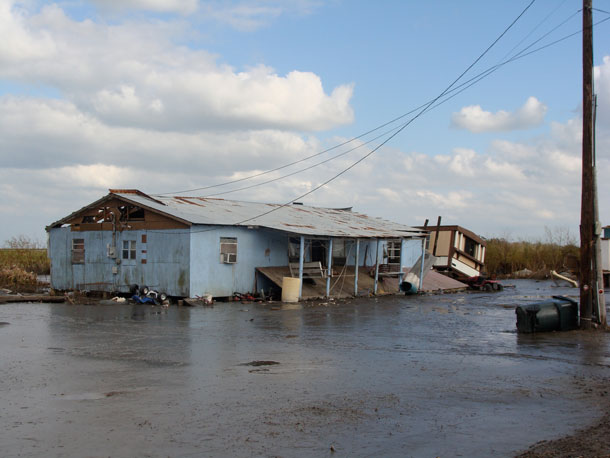
The Isle de Jean Charles off the coast of Louisiana has lost more than ninety percent of its landmass in the last fifty years. The Native community living on the island became the country’s first climate refugees, forced to leave their flooded home in 2016. (Photo: Karen Apricot, Flickr CC BY-NC-ND 2.0)
CURWOOD: The monster hurricanes we’re seeing today are indicators that climate disruption is upon us. But many people still see it as a problem of the future. Yet across the United States it doesn’t take a devastating storm for scientists and citizens to see the unwelcome transformation that is happening right now, as our planet is warming, ocean levels are rising as well. From Louisiana, to Florida to Staten Island, writer Elizabeth Rush set out to document the stories of people caught in these rising tides. Her book is called Rising, Dispatches from the New American Shore, and she joins us from Exeter, New Hampshire. Welcome to Living on Earth.
RUSH: Hi, Steve. Thanks for having me.
CURWOOD: Now, there are many aspects of climate disruption. Why tell stories of sea level rise in particular?
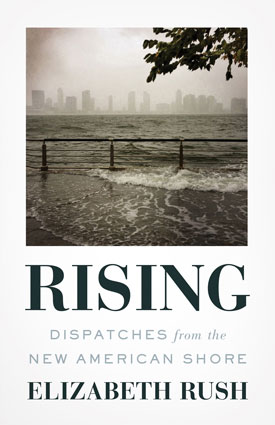
The immediate effects of climate change have already taken the country by storm, as the coast of the United States contends with flooded homes and brutal hurricanes, land erosion and salt contamination, and even the displacement of entire communities. Elizabeth Rush set out to document the stories of people caught in these rising tides. (Photo: Courtesy of Elizabeth Rush)
RUSH: You know, I think one thing that is deeply challenging with writing and reporting about climate change is that it's hard for us to see or feel or point to specifically what climate change feels like. I think it's a little bit easier for us to see the early impacts and effects of climate change, and sea level rise is something that's unfolding right now in the present tense, and it's affecting hundreds of millions of people around the world already, and so I wanted to write this book really from their perspective, to go on the ground in coastal communities, specifically in the United States, and to ask folks living on the front lines of sea level rise, you know -- what is it that woke you up to this reality and what are you doing to rise to the challenges that it presents?
CURWOOD: A number of your stories really focus on disadvantaged communities, less affluent, with histories of racial discrimination. Why?
RUSH: So, I think when I started writing "Rising", I had this idea that those who lived on the shore, who lived alongside the water were going to be some of the most affluent in this country, and that is partially the case. One of the things that I discovered, though, is that many of the places that are flooding now as sea levels rise are sited on top of or alongside tidal wetlands. And tidal wetlands have long been viewed as wastelands, they've long been viewed as sort of unfit for human development, certainly in post-contact in North America. And that means that they're some of the last places to get developed, and the housing prices often are lower in these areas because they have flooding problems from the get-go. So, something that I discovered as I was writing this book was that the places that are flooding worse and worse year after year now are often lower income communities of color.
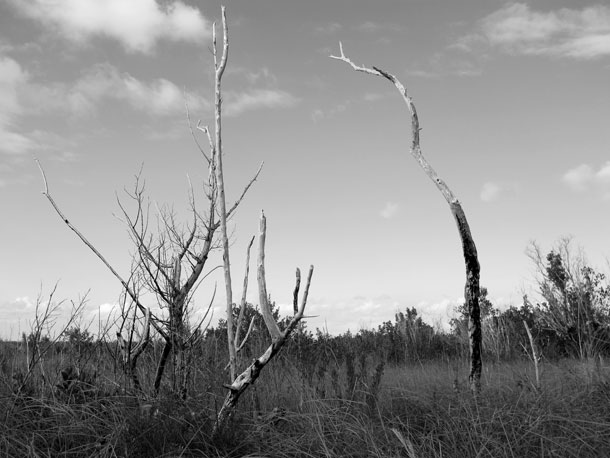
Tidal wetlands contain a diverse ecosystem, providing refuge to an array of plants and wildlife. Historically, they have also been home to low-income, marginalized communities due to low property values. Flooding and salt intrusion pose a serious threat to the land and its residents. (Photo: Courtesy of Elizabeth Rush)
And those communities end up living in tidal wetlands or alongside, or are sited on top of former tidal wetlands. If you look at Pensacola, Florida, Pensacola was tidal wetlands swampy marshland, and it was one of the main destinations that runaway slaves sought out, and part of the reason they sought this area out was because those wetlands sort of acted as an invisibility cloak. Wetlands are easy to defend and difficult to attack, and the land itself tends to not be very coveted. So, that was something that I discovered writing this book, was that some of the people who are feeling the oceans gathering force now are those who have historically been economically and socially disadvantaged in this country.
CURWOOD: Well, I want to hear some of these stories from you now; tell me the story of Chris Brunet.
RUSH: I should start and just say that over the course of writing this book, he's become a good friend and he's one of the first people that I really reached out to and spent a lot of time with who was living on the front lines of climate change. He's a resident of the Isle de Jean Charles, which is about an hour and a half southwest of New Orleans, and one thing that you need to know about the coast of Louisiana is that it is losing ground at an absolutely stunning rate. So, they've lost since roughly 1950, an area in size equal to the state of Delaware.
So, Chris Brunet, he lives on this island. That island has lost over 90 percent of its landmass in the past 50 years, and it's an island that is inhabited by a group of people that are Biloxi, Chitimacha, Choctaw, and Acadian. So, they're all of these different indigenous groups that were displaced in fleeing colonial violence, ended up sort of on the soggy fringes of the state of Louisiana, in part, because that land wasn't necessarily that desirable to begin with and they've lived there for a couple hundred years. Over the past 50 years or so they've just watched this land disappear under high tide, and now you sit in Chris Brunet's house and you're surrounded by high water, and he has photographs that show his childhood -- he lives in his childhood home -- he can look back, look at these photographs that are from 40 years ago and everything is pasture around his house, and you've got cows grazing at his mom's growing okra and cantaloupes and persimmons. And all of that, that way of life, living close to the land and really surviving off the land, is gone, has disappeared because of this combination of sea level rise and other compounding factors.
In 2016, Hurricane Sandy devastated homes across New York and New Jersey. Residents had to face the difficult decision: rebuild, or leave? (Photo: Courtesy of Elizabeth Rush)
So, in 2016 I was reading The New York Times and the front page said, “United States’ first climate change refugees.” It was a story about the island and this grant that they had just received for $48 million dollars to relocate as a group. And I called Chris, and I said, “are you leaving?” And I can still hear his voice in my mind. He said, “we're not celebrating but we are going.” I was able to go back out to the island a couple months later and just knowing that they were going to be relocating, leaving this land, that this land was really going to disappear and that the human history of folks living in it, it wasn't going to be grounded in that place anymore. That community had to hold on to it through their stories, through their history projects and community centers, but that that community in that place was no longer going to be there. It just totally changed my perspective.
CURWOOD: You write about the use of language to deal with the loss of places; it’s a way to comfort folks who have lost the place that was home for themselves and their ancestors. Talk to me about that, please.
RUSH: Well, that question is one that came up often for me as a writer as I was writing this book. I've always thought of language as very powerful and I'll never forget chatting with a man named John Bear Mitchell, who is a Penobscot historian and member of the Penobscot tribe up in northern and central Maine. And he said, you know, our ceremonies still include the caribou even though they don't live here anymore. And that just struck me as something that was deeply meaningful to me in this conversation.
CURWOOD: Now, some of your stories focus on communities that suffer racial discrimination, have low incomes. Now, some might say that could give a false sense of comfort to the more affluent and maybe seduce them into thinking their money could help them escape the rising tides, or at least delay the pain past their lifetimes. What would you say to such a critic?
RUSH: In the most immediate sense, I get it. If you have enough money you can build up on stilts, you can pay for the insurance, you can sort of build a buffer around yourself that might make you seem sort of lifted above that vulnerable position, both metaphorically and physically. And the reality is those homes are deeply dependent upon all of the different kinds of infrastructure that service them, so roadways and gas pipelines, and electric lines and telecommunication lines. There might be a sense that you can sort of lift your home above the high tide, but you can't -- it's really very difficult to lift everything that that home depends upon above the high tide.
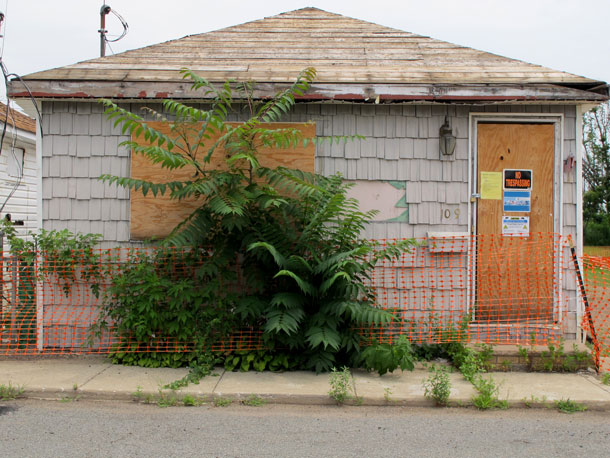
Oakwood Beach, a community in Staten Island, made the decision to relocate after Hurricane Sandy by taking part in a state buyout program. The old houses will be knocked down and the land will remain undeveloped, returning to nature and acting as a protective barrier along the coast. (Photo: Courtesy of Elizabeth Rush)
The other thing, and I see this in Miami Beach is, OK, Miami Beach is pumping hundreds of millions of dollars into sea level rise-ready infrastructure. They're installing flood pumps and they're raising roadways. Well, that community of often very wealthy people, I think, is in ways that we don't often pay attention to, deeply linked to many of the surrounding communities as well, the lower income communities, the working class communities, those folks go out there and they work in the public sector, they are sanitation workers, they work in the hotels, they work in the restaurants. So, I think that they that we can just lift the wealthy above the high tide line and nothing will change is just fundamentally flawed. We are all in this together, and the sooner we can wrap our heads around that, the better I think.
CURWOOD: Elizabeth, please tell me the story of Nicole Montalto.
RUSH: So, Nicole Montalto is a young woman from a community on the eastern shore of Staten Island named Oakwood Beach, and I'll tell you the story of how I met Nicole. Essentially, I was teaching at the College of Staten Island at the time and had started to write about sea level rise. I had already been to Louisiana. Then Hurricane Sandy happened. It was profoundly devastating on the eastern shore of Staten Island.
And then a couple months after this storm, I started to hear murmurs about a coastal community that was working class, right-leaning, often but not always climate change denying, and they had started a public campaign to have the state use disaster recovery funding to purchase and demolish their seaside homes. They didn't feel safe living there any longer. They had been flooding worse and worse year after year. So, I started to interview people out there, and about six months into that process, one of the women I had interviewed, a woman named Patty Schneider, said, it's coming up on the anniversary of the storm and we're having a celebration of life ceremony for my brother who passed away and I'd really like you to come. And so I went, and there I met Nicole Montalto, and she's the daughter of Leonard Montalto, a man who died in the storm, who died in Sandy.
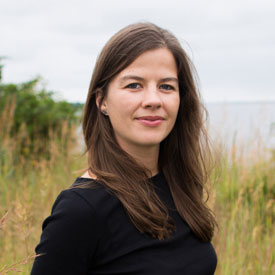
Elizabeth Rush is a visiting lecturer of creative nonfiction at Brown University and author of Rising: Dispatches from the New American Shore. (Photo: Courtesy of Elizabeth Rush)
And I'll never forget it, I was standing in her Aunt Patty's kitchen, and Nicole took me by the arm and she said, you're writing a book and you're going to help commemorate my father, and I want to tell you the story of Sandy. And she sat me down and she talked for two hours. And, you know, she had been living at home during the storm, and she was there with her father and things kept getting worse and worse and eventually her father told her you have to leave. And so she fled and that was the last she ever saw her father, Leonard Montalto. And they searched for him for a couple days after the storm and eventually found him drowned in their basement. Nicole told me this whole story and I felt immediately that there was nothing that I could do as a writer to make it any better than the way she told it. So, her voice opens a chapter on Staten Island and I think of it as a testimony, as bearing witness to these profound changes.
CURWOOD: So, how fair is it to say that your book is ultimately about grief?
RUSH: Part of me thinks of it as elegy, as a kind of elegy for the coastline as we've thought of it for many, many centuries. But, there's also for me a kernel of hope in the book, and for me that comes back to that story of Oakwood Beach in Staten Island.
CURWOOD: So, what's the advantage of us working on the reality of climate disruption, in particular sea level rise – collectively, together?
RUSH: I do think that as communities on the front lines of this problem begin to pay attention to, and live more profoundly sort of with that awareness of the Earth and its changes, that hopefully I think it can usher in a new sort of understanding of human beings and our place on this planet. That is a huge tall order, and I do think that it will probably mean the end of certain political systems that we've had for centuries in this country, but political systems change. We know that, and I think people have a hard time thinking outside of capitalism, but I imagine that climate change will fundamentally challenge and sort of overturn that political system in the long run. I think it's up to us to, to see each other through with justice and empathy and an awareness that we are all in this together.
CURWOOD: Elizabeth Rush is the author of "Rising Dispatches from the New American Shore". Thanks so much for taking the time with us today, Elizabeth.
RUSH: Thank you, Steve, for having me, it's been a pleasure.
Related links:
- Elizabeth Rush's website
- Rising: Dispatches From The American Shore
- NYTimes | "Resettling the First American ‘Climate Refugees’"
- Reuters | "New York lets neighborhood return to nature to guard against storms"
[FROGS CHIRPING]
BASCOMB: Before we go, we leave you in Las Marias, Puerto Rico in the company of Coqui frogs.
[FROGS CHIRPING, NIGHT SOUNDS]
Coquis are endemic to Puerto Rico and a national symbol for the island.
[FROGS CHIRPING]
Frogs, including coquis, were heavily impacted by Hurricane Maria, but within months of the storm they could once again be heard across the island.
[FROGS CHIRPING]
A welcome sign that life would eventually get back to normal.
I recorded these coqui in the mountains of Puerto Rico on a June evening.
[MUSIC: Gipsy Kings, “Obsesion De Amor” on Compas, by T. Baliardo, Nonesuch Records]
CURWOOD: Living on Earth is produced by the World Media Foundation.
Our crew includes Naomi Arenberg, Thurston Briscoe, Savannah Christiansen, Jenni Doering, Jaime Kaiser, Don Lyman, Aynsley O’Neill, Jake Rego, Adelaide Chen, and Jolanda Omari.
BASCOMB: Tom Tiger engineered our show. Alison Lirish Dean composed our themes. You can hear us anytime at L-O-E dot org, iTunes and Google play- and like us, please, on our Facebook page - PRI’s Living on Earth. And we tweet from @livingonearth. I’m Bobby Bascomb.
CURWOOD: And I’m Steve Curwood. Thanks for listening!
ANNOUNCER: Funding for Living on Earth comes from you our listeners and from the University of Massachusetts, Boston in association with its School for the Environment, developing the next generation of environmental leaders. And from the Grantham Foundation for the Protection of the Environment, supporting strategic communications and collaboration in solving the world’s most pressing environmental problems. Support also comes from the Energy Foundation, serving the public interest by helping to build a strong clean energy economy.
ANNOUNCER 2: PRI, Public Radio International.
Living on Earth wants to hear from you!
Living on Earth
62 Calef Highway, Suite 212
Lee, NH 03861
Telephone: 617-287-4121
E-mail: comments@loe.org
Newsletter [Click here]
Donate to Living on Earth!
Living on Earth is an independent media program and relies entirely on contributions from listeners and institutions supporting public service. Please donate now to preserve an independent environmental voice.
NewsletterLiving on Earth offers a weekly delivery of the show's rundown to your mailbox. Sign up for our newsletter today!
 Sailors For The Sea: Be the change you want to sea.
Sailors For The Sea: Be the change you want to sea.
 The Grantham Foundation for the Protection of the Environment: Committed to protecting and improving the health of the global environment.
The Grantham Foundation for the Protection of the Environment: Committed to protecting and improving the health of the global environment.
 Contribute to Living on Earth and receive, as our gift to you, an archival print of one of Mark Seth Lender's extraordinary wildlife photographs. Follow the link to see Mark's current collection of photographs.
Contribute to Living on Earth and receive, as our gift to you, an archival print of one of Mark Seth Lender's extraordinary wildlife photographs. Follow the link to see Mark's current collection of photographs.
 Buy a signed copy of Mark Seth Lender's book Smeagull the Seagull & support Living on Earth
Buy a signed copy of Mark Seth Lender's book Smeagull the Seagull & support Living on Earth

